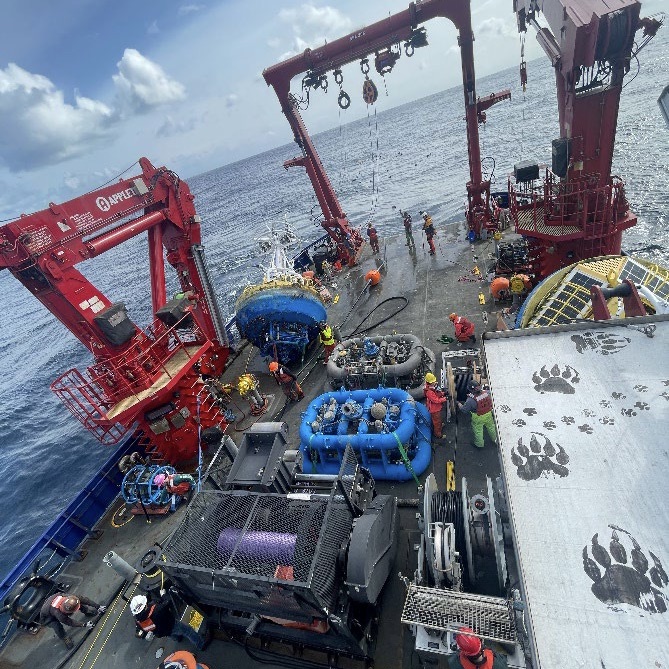
The NSF OOI Coastal Pioneer Mid-Atlantic Bight Array was initiated in 2016 as a re-locatable coastal array suitable for moderate wave and current regimes on the continental shelf and upper slope. In 2024 the Array was relocated off the coast of North Carolina. For more information about the Coastal Pioneer Mid-Atlantic Bight Array please see the U.S. NSF OOI page.
This move was informed by a two-phase, Innovations Lab series between January and June of 2021. After consideration of input from the first Innovations Lab, held in April 2021, NSF proposed the Southern Mid-Atlantic Bight (MAB) as the new location for the Pioneer Array. The second Innovations Lab was held in June 2021 to help determine key science questions, array configurations, and potential partnerships. For more information on this process see here.
Image credit: Jon Fram, OSU

NSF OOI Coastal Pioneer Mid-Atlantic Bight Array is located off the coast of North Carolina, and consists of a mooring array supplemented by glider and AUV transects. Image from OOI website.
Components of the Array
The backbone of the Pioneer Array is a frontal-scale, T-shaped moored array located off the coast of Nags Head, North Carolina, starting ~25 km offshore and extending ~50 km east/west and ~50 km north/south across the continental shelf, centered near the shelf-break front. Three electro-mechanical surface moorings and seven profiler moorings occupy the array. Each surface mooring incorporates a surface buoy with multiple sources of power generation and multiple surface and subsurface communications systems. The surface moorings support a Near-Surface Instrument Frame (NSIF) and are anchored by an instrumented Multi-Function Node (MFN) on the seafloor. Five profiler moorings with surface expressions for data telemetry support wire-following profiling packages with a multidisciplinary sensor suite. Two shallow-water profiler moorings support a wave-powered profiler capable of sampling the upper 80% of the water column, to within a few meters of the air-sea interface. The ten moorings occupy seven sites; three sites contain both a surface mooring and a profiler mooring.
Objectives
To provide synoptic, multi-scale observations of the outer continental shelf, shelf break region, and continental slope, the moored array is supplemented by six mobile platforms – four Coastal Gliders and two AUVs. The role of the gliders is to provide transects along and across the shelf, and to monitor the mesoscale field of the slope sea, resolving rings, eddies, and meanders from the Gulf Stream as they impinge on the shelfbreak front. The AUVs provide synoptic across- and along-front transects – “snap shots” of the front on time scales shorter than those on which the system changes.

Environmental Elements
The MAB continental shelf north of Cape Hatteras, NC, is characterized by a persistent equator-ward current originating from the north, a shelfbreak front separating shelf and slope waters, distributed buoyancy inputs from rivers, variable wind forcing, and intermittent offshore forcing by Gulf Stream rings and meanders. The Pioneer MAB Array is designed to resolve transport processes and ecosystem dynamics in the vicinity of the shelfbreak front, which is a region of complex oceanographic dynamics, intermittent mesoscale variability, and enhanced biological productivity. The Array collects high-resolution, multidisciplinary, measurements spanning the continental shelf and slope on horizontal scales from a few kilometers to about one hundred kilometers.
